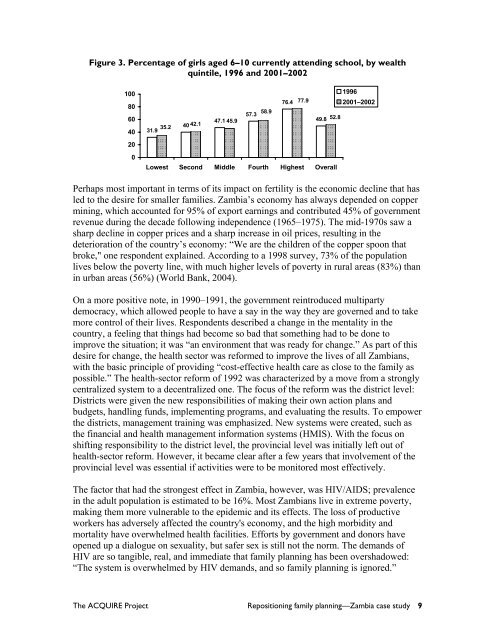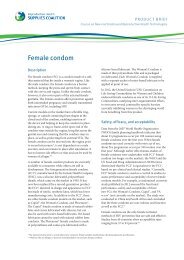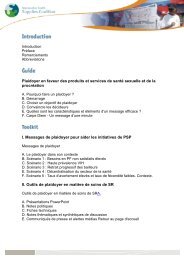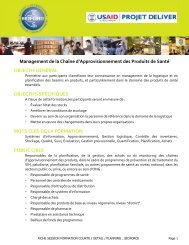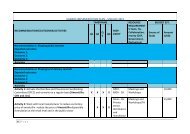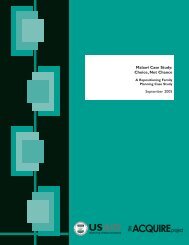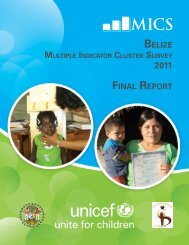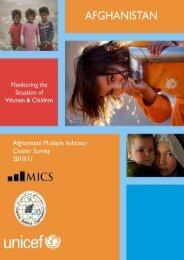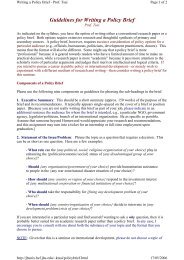Zambia Case Study: Ready for Change - Reproductive Health ...
Zambia Case Study: Ready for Change - Reproductive Health ...
Zambia Case Study: Ready for Change - Reproductive Health ...
Create successful ePaper yourself
Turn your PDF publications into a flip-book with our unique Google optimized e-Paper software.
Figure 3. Percentage of girls aged 6–10 currently attending school, by wealth<br />
quintile, 1996 and 2001–2002<br />
100<br />
80<br />
60<br />
40<br />
20<br />
0<br />
1996<br />
76.4 77.9<br />
2001–2002<br />
58.9<br />
57.3<br />
47.1<br />
49.8 52.8<br />
45.9<br />
40 42.1<br />
35.2<br />
31.9<br />
Lowest Second Middle Fourth Highest Overall<br />
Perhaps most important in terms of its impact on fertility is the economic decline that has<br />
led to the desire <strong>for</strong> smaller families. <strong>Zambia</strong>’s economy has always depended on copper<br />
mining, which accounted <strong>for</strong> 95% of export earnings and contributed 45% of government<br />
revenue during the decade following independence (1965–1975). The mid-1970s saw a<br />
sharp decline in copper prices and a sharp increase in oil prices, resulting in the<br />
deterioration of the country’s economy: “We are the children of the copper spoon that<br />
broke," one respondent explained. According to a 1998 survey, 73% of the population<br />
lives below the poverty line, with much higher levels of poverty in rural areas (83%) than<br />
in urban areas (56%) (World Bank, 2004).<br />
On a more positive note, in 1990–1991, the government reintroduced multiparty<br />
democracy, which allowed people to have a say in the way they are governed and to take<br />
more control of their lives. Respondents described a change in the mentality in the<br />
country, a feeling that things had become so bad that something had to be done to<br />
improve the situation; it was “an environment that was ready <strong>for</strong> change.” As part of this<br />
desire <strong>for</strong> change, the health sector was re<strong>for</strong>med to improve the lives of all <strong>Zambia</strong>ns,<br />
with the basic principle of providing “cost-effective health care as close to the family as<br />
possible.” The health-sector re<strong>for</strong>m of 1992 was characterized by a move from a strongly<br />
centralized system to a decentralized one. The focus of the re<strong>for</strong>m was the district level:<br />
Districts were given the new responsibilities of making their own action plans and<br />
budgets, handling funds, implementing programs, and evaluating the results. To empower<br />
the districts, management training was emphasized. New systems were created, such as<br />
the financial and health management in<strong>for</strong>mation systems (HMIS). With the focus on<br />
shifting responsibility to the district level, the provincial level was initially left out of<br />
health-sector re<strong>for</strong>m. However, it became clear after a few years that involvement of the<br />
provincial level was essential if activities were to be monitored most effectively.<br />
The factor that had the strongest effect in <strong>Zambia</strong>, however, was HIV/AIDS; prevalence<br />
in the adult population is estimated to be 16%. Most <strong>Zambia</strong>ns live in extreme poverty,<br />
making them more vulnerable to the epidemic and its effects. The loss of productive<br />
workers has adversely affected the country's economy, and the high morbidity and<br />
mortality have overwhelmed health facilities. Ef<strong>for</strong>ts by government and donors have<br />
opened up a dialogue on sexuality, but safer sex is still not the norm. The demands of<br />
HIV are so tangible, real, and immediate that family planning has been overshadowed:<br />
“The system is overwhelmed by HIV demands, and so family planning is ignored.”<br />
The ACQUIRE Project Repositioning family planning—<strong>Zambia</strong> case study 9


